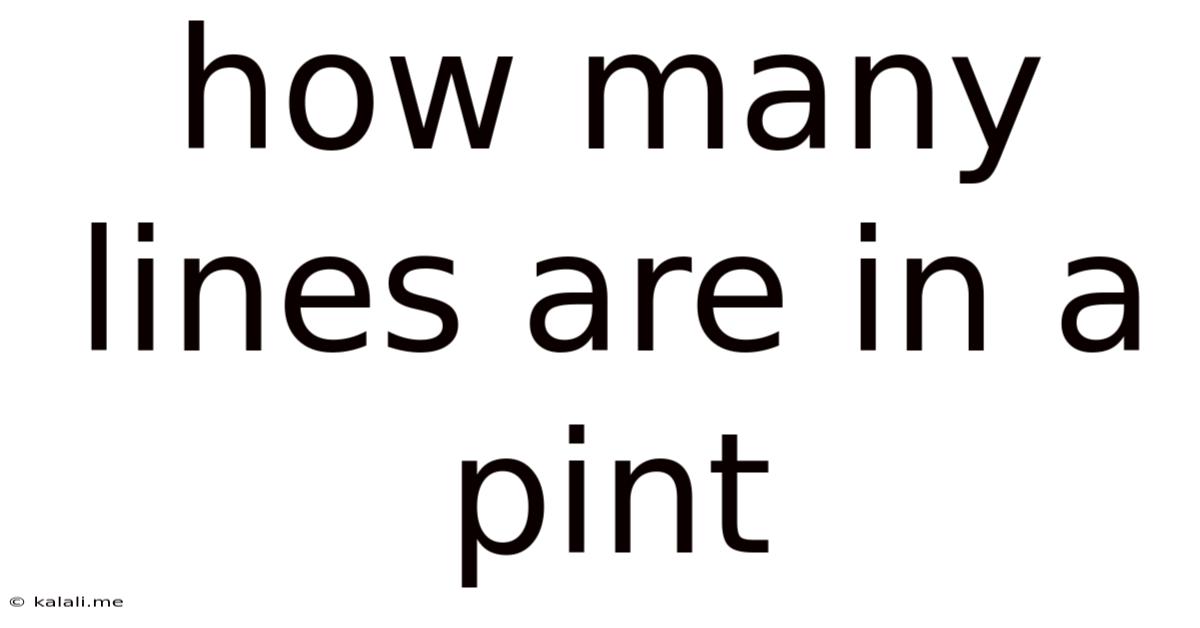How Many Lines Are In A Pint
Kalali
Jun 30, 2025 · 4 min read

Table of Contents
How Many Lines Are in a Pint? Unpacking a Seemingly Simple Question
This seemingly straightforward question – "How many lines are in a pint?" – actually opens a fascinating exploration into the nature of measurement, dimensionality, and the limitations of applying simple metrics to complex realities. There's no single, universally accepted answer, because the question itself requires clarification and context. To understand why, let's delve into the multifaceted aspects of this inquiry.
Understanding the Ambiguity: Lines, Pints, and Dimensions
The primary source of confusion stems from the inherent ambiguity of both "lines" and "pint." A "pint" is a unit of volume, typically associated with liquids. It's a three-dimensional measurement, referring to the amount of space a liquid occupies. Conversely, a "line" is a one-dimensional concept, typically a linear segment. Directly correlating these disparate dimensions presents a significant challenge.
To even attempt an answer, we must first define what kind of "line" we are discussing:
- Lines of liquid: Are we talking about the number of visible lines if the pint glass were etched with markings? This would depend entirely on the markings of the specific pint glass. Some glasses have no markings, others have one line indicating the full pint, and some have multiple lines indicating sub-divisions of the pint (e.g., half-pints, gills).
- Lines of sight: Perhaps we are considering the number of lines of sight that intersect the volume of the pint. This would depend on the observer's perspective and the number of sightlines intersecting the pint. This is a complex geometrical problem.
- Lines of code: If viewed through a more abstract lens, we might consider the lines of code required to create a digital representation of a pint. This depends on the complexity of the software and the detail required in the representation.
- Lines on a label: Some pint containers might have lines or text in their labels, though this isn't related directly to the volume itself.
The Practical Implications of Pint Markings
The most common interpretation of "lines in a pint" refers to the markings on a pint glass or container. The number of these markings is highly variable.
- Unmarked Pint Glasses: Many pint glasses, especially those used in pubs and bars, lack any markings beyond perhaps a single indication of the full pint line. In this case, the answer would be one.
- Marked Pint Glasses: Others might have more markings, subdividing the pint into half-pints, quarter-pints, or even smaller increments. The number of lines would then depend entirely on the specific design of the glass. Some measuring jugs have multiple graduated lines for highly precise measurements.
- Variations in Measurement Standards: The precise volume of a "pint" can even vary slightly depending on the region and the standards in use. Imperial pints (used in the UK) differ from US liquid pints, for example. This subtle variation in volume would not affect the number of lines but underscores the complexity of defining "a pint."
Beyond the Physical: Exploring Abstract Interpretations
Moving beyond the literal interpretation, let's consider more abstract perspectives:
- Molecular Lines: At a microscopic level, a pint of liquid is composed of countless molecules and their interactions. The number of potential "lines" connecting these molecules is astronomically high, bordering on incalculable.
- Mathematical Lines: We could imagine mathematically defined lines within the three-dimensional space occupied by the pint. The number of such lines is practically infinite.
- Digital Lines: If we were to digitally represent a pint, using computer-aided design (CAD) software, for instance, the number of lines used would depend on the resolution and detail of the digital model.
The Importance of Context and Precision in Measurement
The ambiguity surrounding "How many lines are in a pint?" highlights the critical importance of context and precision in scientific and everyday measurements. A clear definition of terms is paramount before attempting to answer any quantitative question. The question fails to specify the type of "line" or even the type of pint being considered.
To get a meaningful answer, we need to specify:
- The type of pint: Imperial pint, US liquid pint, or another unit of measurement.
- The type of container: Glass, jug, bottle, etc.
- The presence and type of markings: Does the container have markings, and if so, how many and what are their increments?
Conclusion: A Multifaceted Question with No Single Answer
There's no single definitive answer to "How many lines are in a pint?" The question is fundamentally ill-defined because it conflates different dimensions and lacks sufficient context. The number of "lines" depends entirely on the interpretation of "line" and the specific characteristics of the pint and its container. This seemingly simple query serves as a powerful illustration of the importance of clarity, precision, and contextual understanding in scientific and quantitative inquiries. The exercise reveals more about the nature of measurement and the limitations of simple analogies than it does about any specific numerical answer. The focus should be on understanding the underlying ambiguity and the need for precise definitions when dealing with measurements of any kind.
Latest Posts
Latest Posts
-
How Long Does It Take To Drive 130 Miles
Jun 30, 2025
-
How Many Cubic Feet Is A 5 Gallon Bucket
Jun 30, 2025
-
Is Joan Osborne Related To Ozzy Osbourne
Jun 30, 2025
-
7 Is To 34 As 5 Is To
Jun 30, 2025
-
How Many Bottles Of Water In 3 Liters
Jun 30, 2025
Related Post
Thank you for visiting our website which covers about How Many Lines Are In A Pint . We hope the information provided has been useful to you. Feel free to contact us if you have any questions or need further assistance. See you next time and don't miss to bookmark.